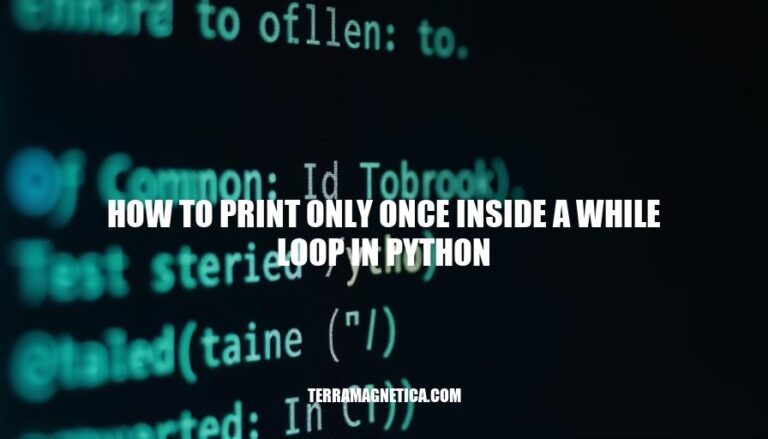


A while loop in Python repeatedly executes a block of code as long as a specified condition remains true. It’s useful when the number of iterations isn’t known beforehand. Here’s a basic example:
i = 1
while i < 6:
print(i)
i += 1
The challenge of printing only once inside a while loop can be tackled by using a flag variable or breaking the loop after the first print statement. Here’s a simple way to do it:
printed = False
while not printed:
print("This prints only once.")
printed = True
This ensures the print statement executes just once, even though it’s inside a while loop.
Here’s a concise explanation:
A while loop in Python repeatedly executes a block of code as long as a specified condition is True.
Syntax:
while condition:
# code block
True, the code block runs.False.To print only once inside a while loop, ensure the condition becomes False after the first iteration. This can be done by modifying a variable that affects the condition.
Example:
i = 0
while i < 1:
print("This prints only once")
i += 1 # Increment i to make the condition False
In this example, the loop runs once because i is incremented, making the condition i < 1 False after the first iteration. This control mechanism is crucial to prevent infinite loops and achieve the desired output.
Here are some common mistakes and pitfalls when trying to print only once inside a while loop in Python, along with ways to avoid them:
Mistake: The loop condition never becomes false, leading to an infinite loop.
while True:
print("This will print forever")
Solution: Ensure the loop condition will eventually become false.
printed = False
while not printed:
print("This will print only once")
printed = True
Mistake: Printing inside the loop without a condition or break statement.
while some_condition:
print("This will print multiple times")
# some_condition never changes
Solution: Use a break statement to exit the loop after printing.
while some_condition:
print("This will print only once")
break
Mistake: Forgetting to initialize variables outside the loop.
while some_condition:
if not printed:
print("This will cause an error")
printed = True
Solution: Initialize variables before entering the loop.
printed = False
while some_condition:
if not printed:
print("This will print only once")
printed = True
Mistake: Placing the print statement outside the loop.
printed = False
while some_condition:
if not printed:
printed = True
print("This will never print inside the loop")
Solution: Ensure the print statement is inside the loop.
printed = False
while some_condition:
if not printed:
print("This will print only once")
printed = True
Mistake: Logical errors in the loop condition or print condition.
printed = False
while some_condition:
if printed == False:
print("This might not print as expected")
printed = True
Solution: Double-check the logic of your conditions.
printed = False
while some_condition:
if not printed:
print("This will print only once")
printed = True
By addressing these common mistakes, you can ensure your while loop prints only once as intended.
Here are practical solutions with code examples to print only once inside a while loop in Python using flags or counters:
flag = False
while True:
if not flag:
print("This will print only once.")
flag = True
# Other loop operations
# Break condition to exit the loop
break
counter = 0
while True:
if counter == 0:
print("This will print only once.")
counter += 1
# Other loop operations
# Break condition to exit the loop
break
while True:
print("This will print only once.")
# Other loop operations
break
These examples ensure the print statement executes only once within the loop.
Here are some advanced techniques and best practices to ensure a print statement executes only once inside a while loop in Python:
Using a break statement:
while condition:
print("This will print only once")
break
Using a flag variable:
printed = False
while condition:
if not printed:
print("This will print only once")
printed = True
Using a counter:
counter = 0
while condition:
if counter == 0:
print("This will print only once")
counter += 1
Using a function:
def print_once():
print("This will print only once")
while condition:
print_once()
break
Using a while-else construct:
while condition:
print("This will print only once")
break
else:
pass
These methods ensure the print statement executes only once, regardless of the loop’s condition.
You can use various techniques such as:
break statement to exit the loop after printingwhile-else construct to execute code outside the loop when the break condition is metThese methods guarantee that the print statement executes only once, regardless of the loop’s condition. To reinforce your understanding, practice implementing these techniques in different scenarios and explore their applications in real-world coding situations.